ISICAM SYSTEM C SERIES
Thickness and Standard Dimensions
Pane windows of the dimensional tolerance (according to EN 1279 ‘a)
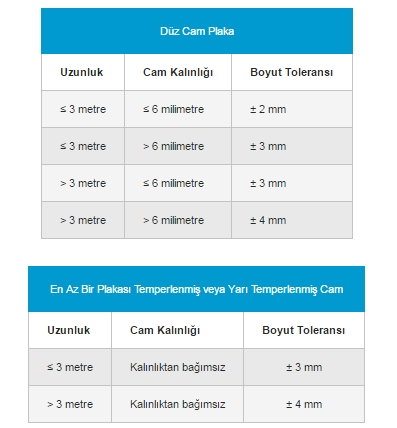
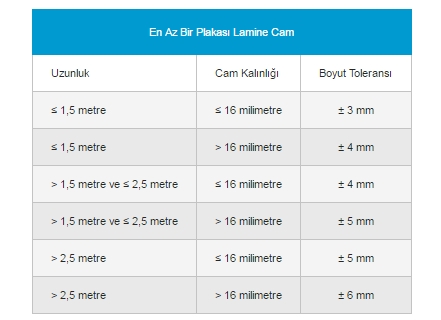 Insulating Glass unit thickness tolerances
Insulating Glass unit thickness tolerances
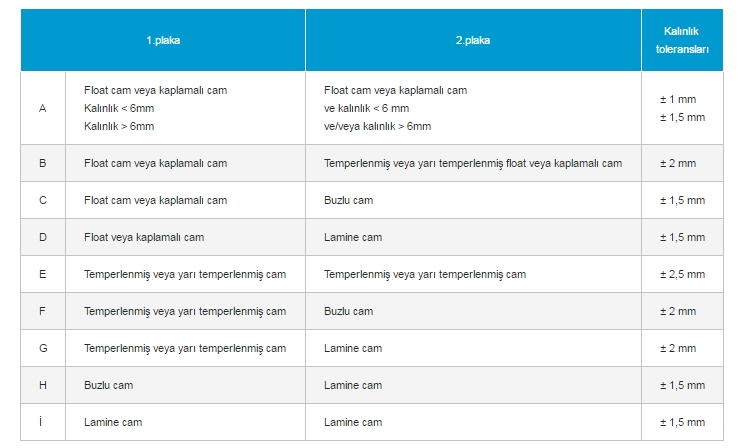 misalignment tolerance between the insulating glass unit plates
misalignment tolerance between the insulating glass unit plates
shift amount between the lower and upper glass pane windows forming plate may be up to 1.5 mm.
The newly built or renovated with solar control glass used in residential and commercial buildings.
Insulating Glass Systems C-Series is the classic series that provides a standard level of insulation and savings generated by Isıcam assurance.
Advantages
Insulating Glass Systems, produced by Sisecam Flat Glass audited regularly by the Insulating Glass Manufacturers Authority.
Isıcam brand in production;
- Window and door proper quality and amount of materials are used,
- constantly under appropriate conditions of production and assurance that is carried out by using modern technologies.
Insulating Glass Systems, it Insulating Glass for 10 years against manufacturing defects originating from the Authorized Manufacture is guaranteed.
Definition
Insulating Glass Systems C-Series is the classic series that provides a standard level of insulation and savings generated by Isıcam assurance.
Personalize Your Isıcam’ı with Additional Features
Insulating Glass CL: Safety and Security providing Şişecam laminated insulating glass unit produced using glass prevents injuries which may occur by preventing breakage of the glass in addition to the dispersion of heat insulation.
Insulating Glass C AL: Noise control which Şişecam Acoustic laminated glass produced using the insulating glass unit, which reduces switching noise by providing sound insulation in addition to the heat-insulating laminated glass safety and Şişecam
Also it has a safety feature.
Isıcam CR: Solar control feature that allows Sisecam produced using colored flat glass insulating glass unit, in addition to thermal insulation limits the solar heat input into the building, the sun controls the excessive brightness and air conditioning in environments that use cooling energy consumption, thereby reducing cooling costs.
Isıcam C RF: Solar control feature that allows the reflective glass Şişecam Tentesol and Sisecam Tentesol produced using Titanium insulating glass unit, in addition to thermal insulation inside the building solar heat limits the input monitors the sun’s extreme brightness and air conditioning in environments that use cooling energy consumption, thereby reducing cooling costs. Reflecting feature when viewed from the direction in which the light is strong because it creates a mirror effect. Glass facades in commercial buildings provides visual integrity.

Insulating Glass Systems, manufactured by Şişecam float and / or selling is made of two or more of the dry according to atmospheric pressure, between the glass plate of air or gas in insulating glass unit formed by bringing together under factory conditions to accommodate.
Performance Table

The dual-pane windows that are appropriate National / International Standards
TS EN 1279 3539 Glass – Used in Buildings – Based Insulating Glass Units
the used raw materials that are appropriate National / International Standards
- Pine
- Float EN 572/2
- glass in market supply and final cut sizes EN 572/8
- Frosted EN 572/5
- Tempered EN 1215
- Partial tempered EN 1863
- Lamine EN ISO1254
- Coated EN 1096
- Heat bathroom tempered glass EN 14179
- Other Raw Materials
- In the insulating glass production; By Insulating Glass Flat Glass butyl şişecam prepared in the Approved List of Materials, polysulfide (Thiokol), silicone, polyurethane, dehumidifiers and gap bar (profile) is used. the sealing material used if the sealing material provided Isıcam replaced with another brand located in the Approved List of Materials, 3539 TS EN1279-4 standard conditions must be fulfilled substituents mentioned in item 4.2.2.
Isıcam Quality
- Optical-pane windows and Appearance Quality
- Point DefectsPane windows of the optical and visual quality EN 1279 / is defined in claim 1. Accordingly pane windows forming optic in the corresponding standard glass and appearance quality appearance and quality status of geçerlidir.tek plates, insulating glass can be permitted in the unit is at a level that exceeds the maximum error limit is no need to search additional requirements relevant in this regard. However, a higher level of acceptance, in the customer and in the quality of agreement between the insulating glass unit manufacturer alabilir.ısıcam natural structure and / or physical property information for the optical and visual quality caused by EN 1279/1 is given in Appendix C. .Isıcam point defects in the TS EN 572/8 acceptable level of market supply and applied to glass in the final segment size is valid.
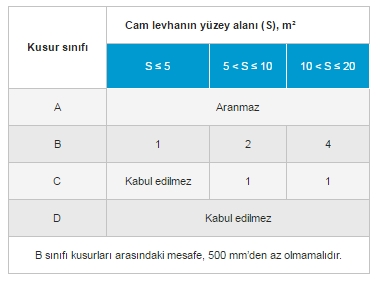
Point Defects Groups
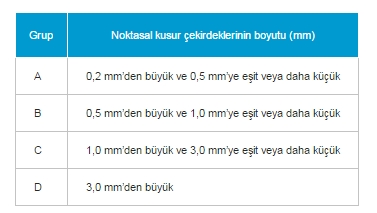
- Produced by Sisecam Flat Glass and / or sales of Solar Low-E, Low-E, in-line produced by solar control coated glass coating in the insulating glass unit, the TS tolerances in EN 1096 Coated glass is standard applies.
- Linear (drawing and erasure) DefectsPane windows of the optical and visual quality EN 1279 / is defined in claim 1. Accordingly pane windows forming optic in the corresponding standard glass and appearance quality appearance and quality status of geçerlidir.tek plates, insulating glass can be permitted in the unit is at a level that exceeds the maximum error limit is no need to search additional requirements relevant in this regard. However, a higher level of acceptance, in the customer and in the quality of agreement between the insulating glass unit manufacturer alabilir.ısıcam natural structure and / or physical property information for the optical and visual quality caused by EN 1279/1 is given in Appendix C. ts EN 572/8 glasses in market supply and final segment size does not allow any linear defect as mentioned in the standard. EN 572/8 and the last segment of the market to supply the standard size glass in the determination of both surface defect observation point on the observation from a distance of 2 m Isıcam standards Although given shall be taken as 1 m. EN 1096 and EN 572/8 hence defects in said pharmaceutically acceptable error, as determined by observation from 1 m.
- Other DefectsAs known, the separator material interposed between the glass plates (lusitana powder, paper etc.) prevents friction with each of the glass maintains the glass surface against humidity and temperature changes. As a powder or paper characteristics interposed between the glass, the composition will not damage the chemical structure is not used any dust or paper. chemical structure as the grain size of the powder used is very important. Therefore it is specially recruited notes and powder to be interposed between the glass and controlled to be formed by the friction of kullanılmaktadır.ca plate in pinpoint worn of airborne moisture condensation or the chemical structure of glass by wetting degradation as a result of corrosion failure occurs. Corrosion failure is seen as white spots in the glass at an advanced stage. In the initial stage it can not be seen with the naked eye. Therefore, next time when the distance on the glass by the method of keeping the steam must be checked for corrosion starts. In insulating glass units are not allowed to corrosion failure. Therefore, attention must be paid to storage and transport of the glass package. When the glass packages shown in particular winter pack temperature, until the package is opened to ambient temperature işlenmemelidir.ar cavity facing the glass plate in the dust, washing pastes, fingerprint, etc. There must be no. at ambient temperature until the package is opened işlenmemelidir.ar cavity facing the glass plate surface dust, washing pastes, fingerprint, etc. There must be no. at ambient temperature until the package is opened işlenmemelidir.ar cavity facing the glass plate surface dust, washing pastes, fingerprint, etc. There must be no.Insulating Glass Edge Features
- CamCam edges should be straight cut, and crushed glass to cause the breakage notch should not take. Thermal stress and so on. breaking and deburring reasons for laminated glass to reduce the risk of cracking process (lapping tape) or the running is recommended.
- Sealant (butyl) It should be especially smooth and continuous, including at the corners. On both sides of the profile butyl weight 2,5 g / m should be. The pressed unit butyl width should be at least 3 mm.
In gas filled unit butyl weight profile on both sides of at least 3, 0 g / m must have its width in the compressed unit must be at least 4 mm. - And insulating paste binder polysulfide (Thiokol) / silicone / poliüretanprofil be slipped into the edge of the unit. Thiokol / polyurethane gap of at least 3 mm and the gap of silicon is at least 6 mm. Structural Glassing used in dual-pane windows, set out in the project design criteria are applied.
In gas-filled cavity unit Thiokol or polyurethane should be at least 4 mm. - Spacer bar (profile) for acceptable deflection profile strip size up to 1 meter up to ± 1 mm is at most ± 2 mm size strips to more than 1 meter. Distance to the glass edge, looking out into the profile of the unit should be a maximum of 15 mm. Structural Glassing used in dual-pane windows, set out in the project design criteria are applied.
It is recommended to use twisted profile in the gas-filled unit. If they cut profile used in the corners of the clip the clip enters the profile above (the surface in contact with the outer sealing paste) it should be closed in an amount of butylated.
Pressure Compensation Practices in dual-pane windows
Insulating glass units, the production plant may be deformed due to differences between the atmospheric pressure and passed the itinerary installation location atmospheric pressure during shipping. pressure equalization is done to prevent it.
- Requiring a pressure compensation cases
- The altitude of the place of installation of the insulating glass unit to be made, the altitude of the place of production; 1200 meters or more and 500 m or lower the unit size and thickness of glass regardless of the pressure equalizing unit operation must be done; It is higher than 700 meters up to 1200 meters and 300 meters to 500 meters from the lower unit of width / height ratio should be determined whether to perform pressure equalization, by looking.
- Regardless of the altitude of the mounting location of the unit will be made; now that when forwarding route is the altitude of the place of production; An altitude of 1200 meters or higher passes through an area of 500 meters or more in case of low elevation unit passes through an area the size and thickness of glass regardless of the pressure equalization unit should be performed; up to 1200 meters from 700 meters to pass through than at high altitudes, in the case passes through an area lower altitudes up to 500 m to 300 m unit width / height ratio by looking been made in pressure equalization it would be decided.
- In case it needs to look at this ratio:
the edge of an insulating glass unit 700 millimeters smaller than the width of all such units / height ratio, regardless of the pressure equalization is done. For example, 1250 × 695 mm in size, pressure equalization to an insulating glass unit of yapılmalıdır.ısıca unit width / height ratio is greater than 2 or 2 is made pressure equalization of this unit. For example, 1500 x a unit width at 720 mm / height ratio of pressure equalization that insulating glass unit is 2.1 the width of yapılmalıdır.ısıca unit / height ratio is less than 2, are made to balance the pressure on the unit. For example, a 1300 unit width x 720 mm in size / height ratio of 1.8 is the pressure equalization is not performed on this insulating glass unit.
- Pressure compensation is applied in the following manner.
- short edge profile of the pressure equalization unit to do (desiccant edge) is drilled from one point in an appropriate manner.
- This hole in the balloon or valve fitted.
- Adequate amount of butyl with the drilled-pane windows, outer sealant (black and white pastes separately) is sent in bags or cans.
- Pane windows in the place where the mounting is shipped immediately after the glass is removed in the balloon or valve opening.
- Severing a piece butyl, softened by heating on a screwdriver, the hole is sealed on the lath.
- On a clean glass or ceramic, 10 parts of white, black 1 part sealant (Thiokol, silicone, polyurethane) are mixed to be homogeneous and the over-butyl closed.
- Insulating Glass after the sealant is dried, the sealed top or side edges of the holes attached to chopping.
Get Information for Your New Project
Feel the difference of experienced team and corporate experience



